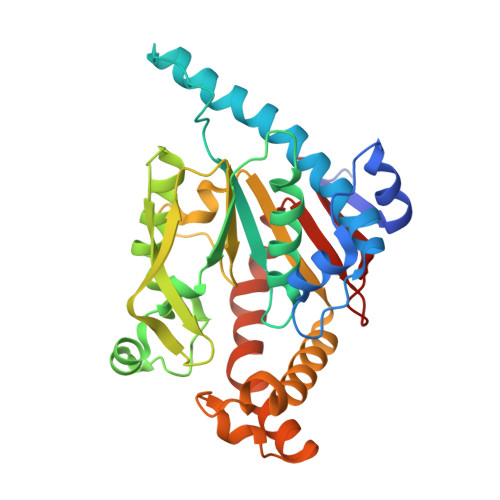M. tuberculosis pantothenate kinase: dual substrate specificity and unusual changes in ligand locations
Chetnani, B., Kumar, P., Surolia, A., Vijayan, M.(2010) J Mol Biol 400: 171-185
- PubMed: 20451532
- DOI: https://doi.org/10.1016/j.jmb.2010.04.064
- Primary Citation of Related Structures:
3AEZ, 3AF0, 3AF1, 3AF2, 3AF3, 3AF4 - PubMed Abstract:
Kinetic measurements of enzyme activity indicate that type I pantothenate kinase from Mycobacterium tuberculosis has dual substrate specificity for ATP and GTP, unlike the enzyme from Escherichia coli, which shows a higher specificity for ATP. A molecular explanation for the difference in the specificities of the two homologous enzymes is provided by the crystal structures of the complexes of the M. tuberculosis enzyme with (1) GMPPCP and pantothenate, (2) GDP and phosphopantothenate, (3) GDP, (4) GDP and pantothenate, (5) AMPPCP, and (6) GMPPCP, reported here, and the structures of the complexes of the two enzymes involving coenzyme A and different adenyl nucleotides reported earlier. The explanation is substantially based on two critical substitutions in the amino acid sequence and the local conformational change resulting from them. The structures also provide a rationale for the movement of ligands during the action of the mycobacterial enzyme. Dual specificity of the type exhibited by this enzyme is rare. The change in locations of ligands during action, observed in the case of the M. tuberculosis enzyme, is unusual, so is the striking difference between two homologous enzymes in the geometry of the binding site, locations of ligands, and specificity. Furthermore, the dual specificity of the mycobacterial enzyme appears to have been caused by a biological necessity.
Organizational Affiliation:
Molecular Biophysics Unit, Indian Institute of Science, Bangalore 560012, India.


















